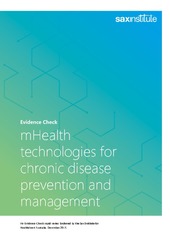| dc.description.abstract | Aims and background: The aim of this rapid review is to examine the evidence relating to the benefits, uptake and operationalisation of mHealth technologies for chronic disease management and prevention. In a context of rapidly emerging technologies, it is important to understand what evidence is available to inform policy interventions designed to integrate technology for health service delivery, especially for services that are accessed by people of varying socio-economic status (SES).
For the purpose of this review, mHealth technologies refer to Short Message Service (SMS)/Multimedia Message Service (MMS), mobile devices (e.g. Personal Digital Assistant [PDA]), mobile apps, wearable devices and sensors. Excluded from this review are telehealth and telephone-based services. The literature from 2005 was reviewed, with a focus on developed countries.
<p> Key findings: The majority of studies included in this review were published after 2010, indicating the relative infancy of this technology and the need for further evaluation of its long-term effectiveness. Of all the mHealth technologies, SMS is the most commonly evaluated in the literature, and that with the strongest evidence of effectiveness. Evidence for interventions containing more innovative technologies, such as those involving smartphone apps and/or wearable devices, has been generated predominately from feasibility and usability studies, with few published randomised controlled trials (RCTs) evaluating effectiveness. For studies focusing on benefits for self-management, diabetes was the most common chronic disease studied. Significant improvements were found in glycaemic control through the use of mobile phones, SMS, internet, and/or wireless devices. For studies focusing on behaviour change, significant improvements were found in physical activity measures, weight loss outcomes, and smoking cessation, among others. The evidence regarding socio-economic and demographic factors of mHealth, as well regarding implementation aspects of mHealth interventions, were generally of lower quality. <p>
Concluding remarks: SMS is the most commonly studied mHealth technology, with the strongest evidence of effectiveness. mHealth interventions can promote significant improvements in glycaemic control (for diabetes patients), as well as in physical activity, weight loss, and smoking cessation, among other outcomes. However, benefits appear dependent upon the characteristics of the intervention (e.g. bundle of features, use of behaviour change theories) and the specific patient population (e.g. age, digital literacy). One important marker of the success of an mHealth intervention is its integration into healthcare as part of a service (and not as a standalone system). One of the greatest barriers to mHealth uptake in healthcare is the existence of competing health system priorities, combined with a lack of evaluation studies and cost-effectiveness analysis to guide decisions.
Improving the uptake and impact of an mHealth service will require the following elements: i) integration into a health service, ii) bundles of features to facilitate action (e.g. decision support, followed by task support), iii) application of appropriate use of theories and behavioural change strategies underpinning program design, iv) strategies employed to maintain participant interest and minimise dropout, and v) ensuring mHealth service fidelity (i.e. the accurate delivery, receipt, and enactment of the service). Strategies to increase uptake of mHealth should address the main barriers for each stakeholder as part of this process: payers, providers and, most importantly, patients. Relevant to Healthdirect Australia, opportunities may arise in providing personalisation and tailoring offered by these emerging mHealth technologies, situating these technologies in the existing ecosystem of Healthdirect Australia, and identifying bundles of mHealth and eHealth features that function together as a service in this ecosystem. | en_US |


 English
English norsk
norsk